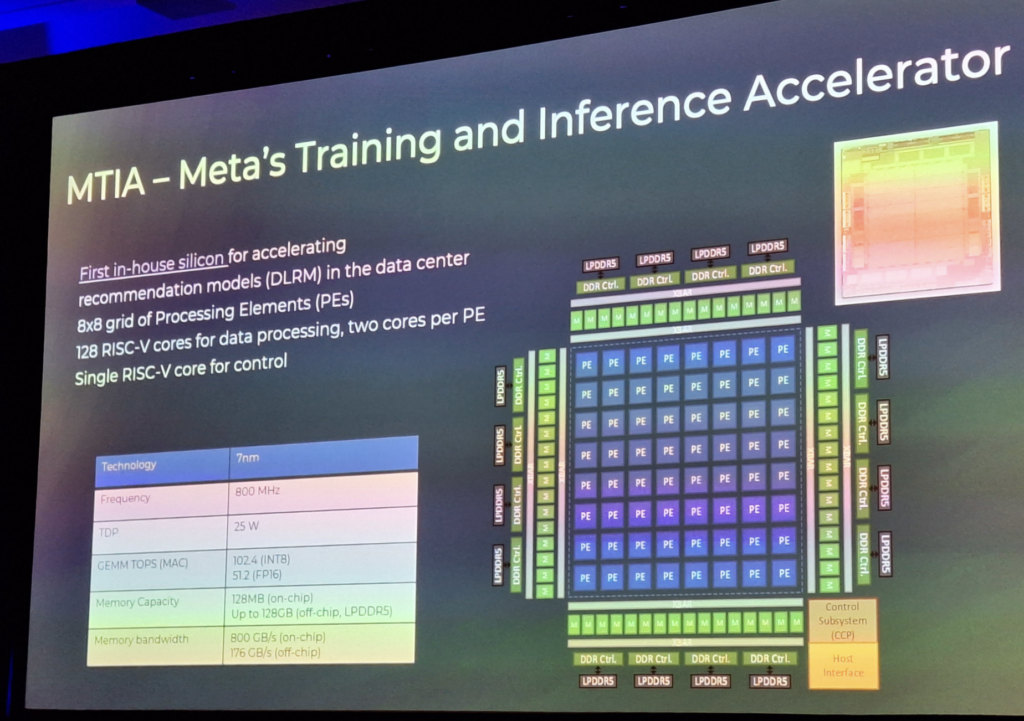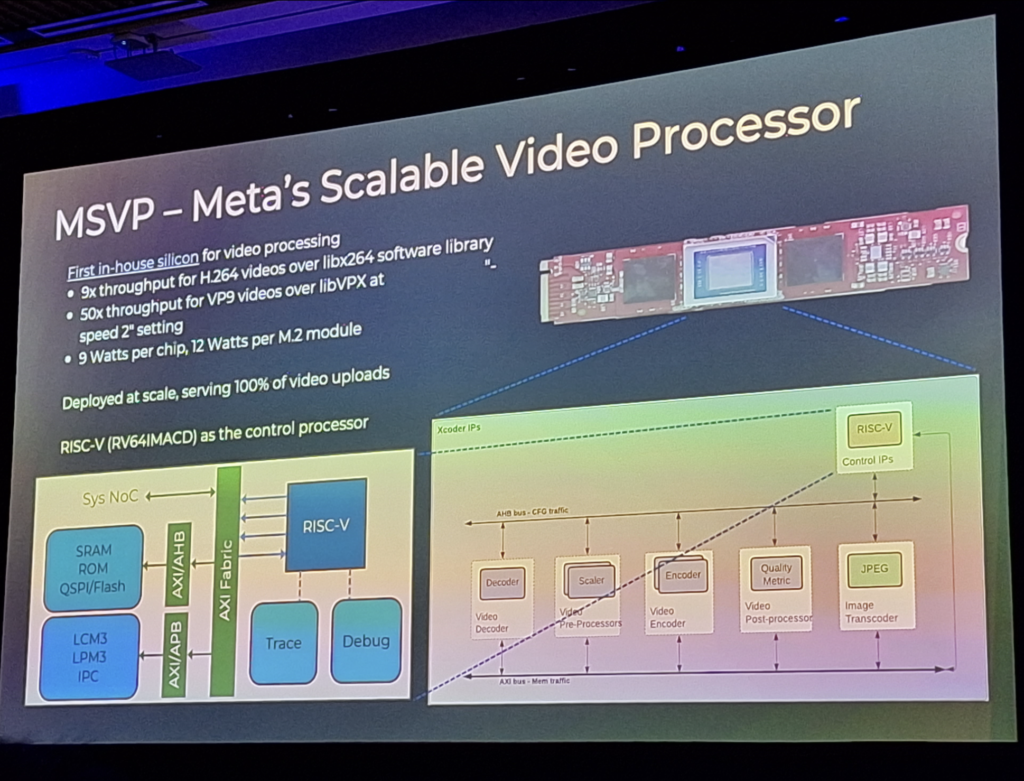Introduction
In a recent statement at the RISC-V Summit, Meta, the tech giant formerly known as Facebook, announced its unequivocal commitment to the RISC-V architecture. This declaration signifies a pivotal moment in the tech industry, as one of the world’s most influential companies takes a definitive stance on the future of semiconductor design.
In this blog post, we will explore the significance of Meta’s decision, delve into the background of the RISC-V architecture, and discuss the potential impact this choice could have on the company’s future product lineup.
“We have clearly identified that RISC-V is the way to go for us going forward for all the products that we have … not only next generation video transcoders but also next generation inference accelerators and training chips.”
~Meta at RISC-V Summit
Join Our WhatsApp News for updated information on semiconductors & AI
Background: The Rise of RISC-V
The RISC-V architecture, pronounced as “risk-five,” is an open-standard instruction set architecture (ISA) designed with simplicity, efficiency, and modularity in mind.
Unlike proprietary ISAs like ARM and x86, RISC-V is an open-source platform, allowing anyone to design, implement, and deploy processors based on this architecture without licensing fees.
Over the past decade, RISC-V has gained substantial momentum and is considered one of the most exciting developments in the semiconductor industry for several reasons:
Read More: How RISC V is the Danger for ARM’s Supremacy
Why is Meta ditching GPU for its AI ?
Meta’s endorsement of RISC-V marks a significant shift in the tech landscape. Historically, the company has relied on various processor architectures, including ARM and x86, for its hardware products.
However, the decision to adopt RISC-V for all future products, from video transcoders to inference accelerators and training chips, is a strategic choice with profound implications.
Meta found that GPUs did not provide the optimal performance for their specific recommendation workloads, prompting them to develop the Meta Training and Inference Accelerator (MTIA) ASICs.
Building custom silicon was a significant endeavor, offering insights for Meta’s chip roadmap and leading to improvements in performance and scalability for future systems. Challenges are arising as memory and interconnect bandwidth scale at a slower pace compared to compute power, impacting workload performance.
Read More: The Story of RISC-V
Meta’s Quest for Customization with RISC-V
Meta has a unique challenge on its hands. They rely on a set of operations in their workloads: matrix multiplications, non-linear functions, and data transfers/layout manipulations.
These operations serve various purposes in different tasks, but Meta aims to have the flexibility to incorporate them into a standard program.
The challenge lies in the fact that the RISC-V instruction set, a widely used processor architecture, does not support these operations.
Why is meta Tinkering with the Core RISC V?
Meta has some solid reasons for customizing the core.
First, they want to maintain control over their intellectual property (IP) and innovations. By tweaking the core to their needs, they can keep their cutting-edge technology secure.
Second, minimizing external interaction is key. By adding these custom operations internally, they can avoid relying on external tools or platforms.
And last but not least, flexibility is vital. In a fast-paced tech world, Meta wants to modify things quickly when requirements change. Customization provides the agility they need to adapt on the fly.
In a nutshell, Meta is customizing the RISC-V core to keep their innovations under wraps, reduce external dependencies, and stay agile in an ever-changing tech landscape.
Read More: Explained: What the hell is RISC-V
Meta’s Training and inference Accelerator
Meta has unveiled its first in-house-designed chip based on the RISC-V architecture, tailored for AI tasks in its Facebook and Instagram services.
This silicon architecture is designed to efficiently manage recommendation models such as DLRM, which require handling complex computations and large datasets effectively.

Meta at RISC V Summit (Image Credits: Agam Shah on X)
Let’s break down the key components of this silicon:
Grid of Processing Elements (PEs):
- The silicon features an 8×8 grid of processing elements, totaling 64 PEs. These PEs are responsible for executing the core computational tasks required for recommendation models.
RISC-V Cores:
- Each PE is equipped with two RISC-V cores dedicated to data processing. This setup allows for parallel data processing within each PE, which can significantly accelerate recommendation model computations.
- In total, there are 128 RISC-V cores distributed across the 64 PEs (2 cores per PE).
Single RISC-V Core for Control:
- In addition to the data processing cores, there is a single RISC-V core dedicated to control tasks. This control core is responsible for managing and coordinating the operations of the PEs and ensuring the overall execution of the recommendation model is coherent.
This silicon architecture is designed to efficiently handle recommendation models like DLRM, which involve complex computations and large datasets.
The parallelism provided by the 8×8 grid of PEs, each equipped with dual RISC-V cores, can significantly accelerate inference and training tasks,
Meta’s Scalable Video Processors
Meta has developed its own custom silicon for video processing. This is the first time they have created their own hardware specifically for handling videos. This silicon is designed to be very efficient at processing videos.

Meta at RISC V Summit (Image Credits: Agam Shah on X)
Here are the key details in simpler language:
Performance Improvements:
- Meta’s new video processors are much faster than traditional software libraries. They can process H.264 videos 9 times faster than the typical software library (libX264). For VP9 videos at the “Speed 2” setting, they are a whopping 50 times faster than the standard software library (libVPX).
Power Efficiency:
- These processors are energy-efficient. They use only 9 watts of power per “chup” and 12 watts per M.2 module. This means they can do a lot of video processing without consuming a lot of electricity.
Scalability:
- Meta has designed these processors to operate at a large scale, handling 100% of the video uploads on their platform. So, whenever you upload a video on Meta, these processors help process it quickly.
Control Processors:
- Meta employs specialized RISC-V processors for controlling tasks to manage and coordinate video processing.
In summary, Meta’s new video processors are super-fast, energy-efficient, and capable of handling a massive number of video uploads on their platform.
Standardized Control Subsystem
Meta has developed a standardized control system suitable for various specialized accelerators designed for different purposes. This system centers on a cluster of RISC-V cores, which function as small computer brains that collaborate effectively.

Meta at RISC V Summit (Image Credits: Agam Shah on X)
Here are the key details :
Control System:
- Meta has developed a control system that can be used in different types of specialized accelerators. This system helps manage and control how these accelerators work.
Multi-Core RISC-V Cluster:
- The control system is made up of several small computer cores called RISC-V cores. They work together in groups of 1, 2, or 4 to handle different tasks efficiently.
Dedicated RISC-V for Security:
- One of these RISC-V cores is dedicated to security. It focuses on keeping the system safe from unauthorized access and managing the resources of the computer chip.
Operating System:
- The control system uses a real-time operating system called Zephyr. Think of this as the software that helps everything run smoothly and quickly.
Extensions:
- The control system is enhanced with extra features and tools, some of which are developed in-house at Meta, while others come from specific vendors.
In summary, Meta has created a control system that can be used in various specialized accelerators. This system uses groups of small computer cores to manage and control the accelerators efficiently. It pays special attention to security, uses a reliable operating system, and adds extra features to make everything work well together.
Read More: ARM’s Grip on the Chip Market Is Being Challenged by RISC-V – Tech Vedas
Conclusion:
The decision to use RISC-V for video transcoders, inference accelerators, and training chips signals Meta’s intent to advance its capabilities in critical areas, particularly artificial intelligence and data processing.
The modularity and customization potential of RISC-V allow Meta to fine-tune its processors for optimal performance, meeting the unique demands of these applications.
This choice could also result in faster development cycles and more energy-efficient hardware, contributing to the company’s competitive edge.




